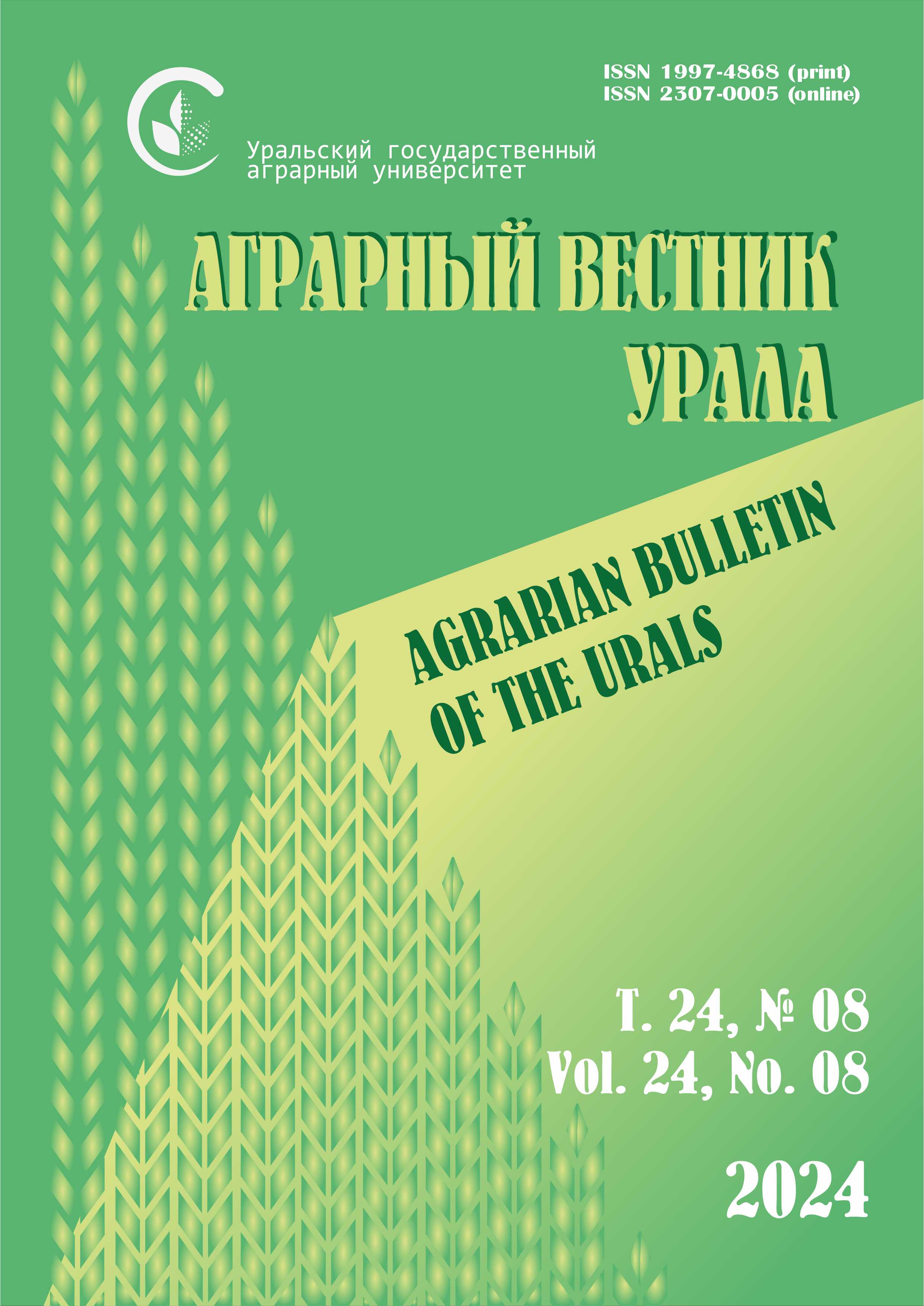Abstract. The current article is aimed at assessing the resistance of sugar beet plants of various hybrids to the phytotoxic effects of herbicides used both in pure form and in combination with silicon-containing ones. Methods. The research was carried out under the conditions of a field experiment, based on 4 repetitions in 2022–2023. Photosynthetic pigments in leaves were determined by optical density in an extract with 96 % ethanol. The influence of herbicides and biostimulants on the formation of plant mass, as well as the chlorophyll content in the leaves and the sugar beets yield of various hybrids were analyzed. Results. It was identified that the combined use of silicon-containing fertilizers “Mikrovit-6 Kremniy”, “Kelik Kaliy+Kremniy” in combination with herbicides contributed to an increase in the weight of one sugar beet plant after three herbicide treatments by 13–17 % depending on the hybrid compared to the option where only herbicides were treated, and the phytotoxicity of pesticides did not exceed 2.0–2.5 %. The sugar beet productivity depended on the toxicological load on the crop plants. In combination with the herbicides Mikrovit-6 Silicon and Kelik Potassium+Silicon, the total content of green pigment was 49–74 % higher than in plants stressed by herbicides, and chlorophyll a increased by 3.1–4.5 times. The domestic selection hybrids F1 Volna and F1 Skala were the most resistant to inhibition of photosynthesis processes. The scientific novelty of the current research lies in the fact that for the first time in the conditions of the Middle Volga region on leached chernozem, the most efficient silicon-containing fertilizers for reducing herbicidal stress of sugar beet plants have been identified. The identified results also contribute to the improvement of the photosynthesis process by increasing the concentration of chlorophyll, a greater average daily increase in biomass and an increase in the yield of sugar beet plants, as well as hybrids of domestic selection that are more stress-resistant to the negative effects of herbicides.
sugar beet, hybrids, herbicides, silicon-containing fertilizers, phytotoxicity, productivity
1. Minakova O. A., Aleksandrova L. V., Vilkov V. M. Vliyanie razlichnyh urovney udobrennosti pochv na osobennosti potrebleniya NPK i urozhaynost' gibridov saharnoy svekly otechestvennoy i inostrannoy selekcii v central'nom chernozemnom regione // Agrohimiya. 2022. № 10. S. 38–46. DOI:https://doi.org/10.31857/S0002188122100064.
2. Zheryakov E. V. Influence of the field storage on the content of basic molasses in roots of various sugar beet hybrids // Scientific Papers. Series A. Agronomy. 2020. Vol. 63, No. 1. Pp. 642–646.
3. Zheryakov E. V., Semina S. A., Gavryushina I. V. Duration of Storage and Quality of Sugar Beet Roots // Research Journal of Pharmaceutical, Biological and Chemical Sciences. 2018. Vol. 9, No. 3. Pp. 1096–1100.
4. Zheryakov E. V., Dmitrieva S. Yu., Bliznov V. A. Zasorennost' posevov saharnoy svekly i ee vliyanie na urozhaynost' korneplodov // Nauchnaya zhizn'. 2019. № 1. S. 15–23.
5. Dyadyuchenko L. V., Dmitrieva I. G. Poisk gerbicidnyh antidotov dlya rasteniy saharnoy svekly // Agrohimiya. 2021. № 5. S. 621–627. DOI:https://doi.org/10.31857/S0002188121050045.
6. Chechetkin Yu. M. Effektivnost' vozdeystviya sovmestnogo primeneniya gerbicidov i regulyatorov rosta na urozhaynost' i tehnologicheskie kachestva korneplodov saharnoy svekly // Sahar. 2020. № 9. S. 40–41. DOI:https://doi.org/10.24411/2413-5518-2020-10904.
7. Dvoryankin E. A. Fitotoksichnost' razlichnyh kombinaciy gerbicidov dlya saharnoy svekly v zavisimosti ot normy rashoda preparatov i fazovoy ustoychivosti k nim sornyakov // Sahar. 2023. № 5. S. 39–43. DOI:https://doi.org/10.24412/2413-5518-2023-5-39-43.
8. Venevcev V. Z., Zaharova M. N., Rozhkova L. V. Effektivnost' ispol'zovaniya gerbicidov v posevah saharnoy svekly // Vestnik rossiyskoy sel'skohozyaystvennoy nauki. 2019. № 5. S. 50–53. DOI:https://doi.org/10.30850/vrsn/2019/5/50-53.
9. Spiridonov Yu. Ya., Larina G. E., Shestakov V. G. Metodicheskoe rukovodstvo po izucheniyu gerbicidov, primenyaemyh v rastenievodstve. Moskva: Pechatnyy Gorod, 2009. 252 s.
10. Islamgulov D., Ismagilov R., Alimgafarov R., Bakirova A., Enikeev R. Technological qualities of sugar beetroot crops under the conditions of the middle cis-ural region // Periódico Tchê Química. 2020. Vol. 17, No. 36. Pr. 72–84. DOI:https://doi.org/10.21498/2518-1017.15.1.2019.162492.
11. Gamuev O. V., Vilkov V. M. Sistema zaschity saharnoy svekly ot sornyakov v sevooborote // Sahar. 2019. № 12. S. 40–43. DOI:https://doi.org/10.24411/2413-5518-2019-00004.
12. Chumikina L. V., Arabova L. I., Kolpakova V. V., Topunov A. F. Fitogormony i abioticheskie stressy (obzor) // Himiya rastitel'nogo syr'ya. 2021. № 4. S. 5–30. DOI:https://doi.org/10.14258/jcprm.2021049196.
13. Dvoryankin E. A. Poteri urozhaya saharnoy svekly ot fitotoksichnosti gerbicidov. Metodika issledovaniya toksichnosti gerbicidov // Sahar. 2018. № 7. S. 25–29. DOI:https://doi.org/10.24411/2413-5518-2018-00041.
14. Grankina A. O., Bocharnikova E. A., Matychenkov V. V. Vliyanie kremniysoderzhaschih biostimulyatorov na holodostoykost' pshenicy i saharnoy svekly // Agrohimiya. 2022. № 2. S. 22–27. DOI:https://doi.org/10.31857/S0002188122080075.
15. Kulikova A. H., Karpov A. V., Yashin E. A. Kremnistye porody v sisteme udobreniya sel'skohozyaystvennyh kul'tur. Ul'yanovsk: UlGAU, 2020. 176 s.
16. Praktikum po fiziologii rasteniy: ucheb. posobie dlya agronomicheskih special'nostey / Pod red. N. N. Tret'yakova. Moskva: KolosS, 2003. 288 s.
17. Posleregistracionnye ispytaniya sortov i gibridov saharnoy svekly v syr'evoy zone saharnogo zavoda. Metodicheskie rekomendacii / Pod red. A. V. Kornienko. Ramon': [b. i.], 2010. 50 s.
18. Kornienko A. V., Nanaenko A. K. Metodika polevogo opyta v sveklovodstve. Ramon': [b. i.], 2004. 104 s.
19. Dvoryankin E. A. Osobennosti rosta i razvitiya saharnoy svekly v period obrabotki poslevshodovymi gerbicidami // Sahar. 2020. № 10. S. 32-35. – DOI:https://doi.org/10.24411/2413-5518-2020-00001.
20. Dvoryankin E.A. Specificheskie i nespecificheskie reakcii rasteniy na gerbicidy // Sahar. 2019. № 8. S. 26–29. – DOI:https://doi.org/10.24411/2413-5518-2019-00046.
21. Glaz N. V., Kazakova N. I., Ufimceva L. V. Metodicheskie podhody k vyboru usloviy probootbora i ocenke soderzhaniya hlorofilla v list'yah rasteniy kukuruzy // Vestnik KrasGAU. 2015. № 3. S. 73–77.









